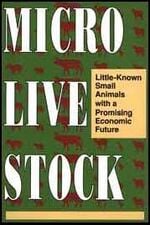The purpose of this report is to raise awareness of the potential of small livestock species and to stimulate their introduction into animal research and economic development programs. It is geared particularly towards benefiting developing nations.
"Microlivestock" is a term we have coined for species that are inherently small, such as rabbits and poultry, as well as for breeds of cattle, sheep, goats, and pigs that are less than about half the size of the most common breeds. These miniature animals are seldom considered in the broad picture of livestock development, but they seem to have a promising future. Wherever land is scarce it seems reasonable to assume that, things being equal, small animals would be more attractive than large ones. And land for livestock is becoming increasingly scarce.
In this report we have emphasized multipurpose species with promise for small holders. In some species, the promise is immediate; in others, it is long term, and much research must be undertaken before that promise can be realized or even understood.
We have included wild species that seem to have potential as future livestock. Some are threatened with extinction but are described here because their economic merits may be the key to acquiring support for their protection. Also we have highlighted rare breeds of domesticated species because the current tendency has been to concentrate on a small number of large breeds, and many potentially valuable breeds are becoming extinct through neglect.
The book was prepared after an intensive survey of more than 300 animal scientists in 80 countries. They suggested more than 150 species for inclusion. The staff then drafted chapters on about 40 species and these drafts were reviewed by more than 400 researchers worldwide. The thousands of resulting comments, corrections, and additions were integrated into the drafts. The panel then met to review the product, to select the most promising species, and to rework the chapters based on their own experiences and joint conclusions. The result is the current 35 chapters. Most of the case studies and accounts of innovations highlighted in the various sidebars were developed by the staff study director.
Collectively, this study covers many species, but it by no means exhausts all the microlivestock possibilities. Lack of space and time precludes discussion of creatures such as edible insects, snails, worms, turtles, and bats, which in some regions are highly regarded foods. Similarly, we have not included aquatic life. These decisions were arbitrary; perhaps invertebrates and aquatic species can be included in future volumes.
This report is addressed to government administrators, technical assistance personnel, and researchers in agriculture, nutrition, and related disciplines who are concerned with helping developing countries achieve a more efficient and balanced exploitation of their biological resources. Hence, we deal with the animals in a general way and do not cover details of biology, husbandry, or economics. A selection of readings that contains such technical information is cited in Appendix A.
A further goal of this project has been to explore the common ground between the disparate arms of animal science: to show that specialists in wildlife, zoology, and livestock science have much to learn from one another's field of expertise; to show that "fanciers" of pigeons, pheasants, chinchillas, iguanas, and other species may have much to offer livestock breeders - including germplasm; and that those who raise "obsolete" breeds are not only playing a vital role in the protection of rare genes but can offer the benefit of their experience to commercial livestock producers.
Throughout this report, the scientific names of mammals follow those in: Mammal Species of the World: A Taxonomic and Geographic Reference. 1982. J.H. Honacki, K.E. Kinman, and J.W. Koeppl, editors. Published by Allen Press, Inc.; and the Association of Systematics Collections, Lawrence, Kansas, USA. All dollar figures are in U.S. dollars; all ton figures are in metric tons.
This report has been produced under the auspices of the Advisory Committee on Technology Innovation (ACTI) of the Board on Science and Technology for International Development, National Research Council. ACTI was mandated to assess innovative scientific and technological advances, with particular emphasis on those appropriate for developing countries. In this spirit, therefore, the current report includes some extremely unusual species. Whether these will eventually prove practical for widespread use is uncertain, but we present them here for researchers and others who look forward to challenges and enjoy the satisfaction of successful pioneering. The domestication of new poultry, as well as the management of rodents, iguanas, and small deer and antelope, should be viewed in this spirit.
Current titles in the ACTI series on managing tropical animal resources are:
- The Water Buffalo: New Prospects for an Underutilized Animal
- Little-Known Asian Animals with a Promising Economic Future
- Crocodiles as a Resource for the Tropics
- Butterfly Farming in Papua New Guinea.
The production of these books has been supported largely by the Office of the Science Advisor of the U.S. Agency for International Development (AID), which also made this report possible.
WARNING[edit | edit source]
How to cite this report:
National Research Council. 1991. Microlivestock: Little-Known Small Animals with a Promising Economic Future. National Academy Press, Washington, D.C.
Cover Design by David Bennett
In the developing countries, there are over 100 million farms of less than five hectares, supporting about 700 million people, who represent about 17 percent of the world population. Even more significant is the fact that about 50 million farms have less than one hectare of land. C. Devendra and Marcia Burns Goat Production in the Tropics We may now be in the wind down stage of bigger is better animal selection trend and it has certainly been a wild ride.... the lesson now being learned is that the bigger breeding animals . . . cost more to maintain, are often slower to reproduce, and may even have a shorter lifespan.
Kelly Klober
Small Farmer's Journal
